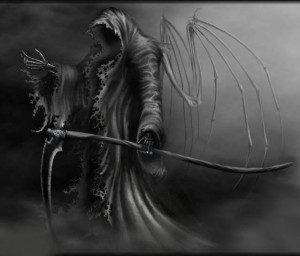 News that eleven of the late Jack Kevorkian’s paintings are up for sale in Los Angeles—at “upward of $45,000 per canvas”—are a reminder that long before there was Kermit Gosnell, there was Jack Kevorkian.
News that eleven of the late Jack Kevorkian’s paintings are up for sale in Los Angeles—at “upward of $45,000 per canvas”—are a reminder that long before there was Kermit Gosnell, there was Jack Kevorkian.
Whereas abortionist Gosnell was angered when the Philadelphia Attorney General called his abortion clinic a “House of Horrors,” Kevorkian (a publicity hound, if ever there was one) gleefully enjoyed being dubbed “Dr. Death.”
Gosnell is serving a life sentence without parole having been convicted of three counts of first degree murder and one count of involuntary manslaughter. I’d like to think if somehow he was ever paroled, collectively we would shun him and surely not turn him into a martyr.
However, that is pretty much what happened to Kevorkian, who was convicted in 1999 of second-degree murder and served eight years in jail. Sentimental martyrdom cum celebrity.
Kevorkian (who passed away in 2011) bragged of having “assisted” the suicides of at least 130 people. From a legal perspective, he was literally untouchable until his overweening ego got the better of him. Kevorkian actually videotaped himself administering a lethal injection to a man with Lou Gehrig ’s disease and then went on CBS’s “60 Minutes” to taunt the legal establishment by showing the video to millions.
Once out of prison, Kevorkian got to hang with the beautiful people when Al Pacino played him in the HBO production of ‘You Don’t Know Jack,” the film that earned Pacino an Emmy and Golden Globe. “Kevorkian cut a vivid image at premieres and awards, sometimes wearing his iconic blue thrift-store sweater with a tuxedo,” wrote Joe Swickard of the Detroit Free Press at the time. “He almost glowed at receptions as women circled him and powerful men elbowed their way through the adoring crush to shake his hand.”
Perfectly intelligent people could—and did—say the most awful, jaw-dropping things. “He was part of the Civil Rights movement — although he did it in his own way,” said Alan Dershowitz, a Harvard professor and lawyer who advised Kevorkian during his legal battles.
“Part of the Civil Rights Movement.” Martin Luther King, Jr. must have turned over in his grave.
When Kevorkian died in June 2011, he was hailed as a “straight-talking doctor,” a man to whom material things meant nothing, a man so devoted to his “cause” that “he never married and had no children, and the people most closely associated with him were his attorney Geoffrey Fieger, who represented him without fee, and one of his faithful, longtime assistants, Janet Good.”
Indeed, in most of the obituaries, the only real question to his admirers was whether Kevorkian was too good for this world.
Three years later, another cycle of admiration, this time (actually, the latest time) for his paintings. “He was a talented amateur,” Lee Bowers, curator of the Smithsonian Institution, told CNN. (Any paintings that are not sold will be given to the Smithsonian.) “He painted throughout much of his life.”
So what was Kevorkian’s subject matter? According to Sabrina Bachai, writing for Medical Daily,
“The exhibition of the Michigan-based doctor has paintings ranging from pictures depicting CAT scan machines to paintings of a suicide machine. Among the series of paintings depicting human suffering is one called ‘Paralysis.’ The piece shows a naked man crouched in a claustrophobic prison, half his body turned to stone, his arms and legs useless, and his brain removed. Another series included, the ‘Thanatron,’ which is a medical contraption that helped to inject drugs into terminally ill and incapacitated patients who wanted to end their lives. It’s going for $25,000.”
Perfect. This does capture Kevorkian’s obsessions which were utterly bizarre and which only a few, such as bioethicist Wesley Smith, bothered to document.
Far from good-guy ascetic, Kevorkian’s “driving motive,” Smith wrote, “was always obsession with death. Indeed, as he described in his book ‘Prescription Medicide,’ Kevorkian’s overriding purpose in his assisted-suicide campaign was pure quackery, e.g., to obtain a societal license to engage in what he called ‘obituary,’ that is, the right to experiment on the brains and spinal cords of ‘living human bodies’ being euthanized to ‘pinpoint the exact onset of extinction of an unknown cognitive mechanism that energizes life.’”
The caption underneath the photo of Kevorkian in Bachai’s story refers to “Dr. Kevorkian pro-euthanasia satirical paintings.”
But Kevorkian was no satirist. He was a man on a mission who took advantage of the unfortunate truth (as Smith wrote at his passing) that “’compassion’ has become the great justifier for breaking laws and violating social norms. Once Kevorkian stopped talking openly about obitiatry and began proclaiming that he was motivated by his care for suffering patients—even calling himself ‘Dr. Life’ in an interview with Barbara Walters—everything changed. His poll numbers rose substantially, the media fawned, and juries repeatedly refused to convict him for crimes he had clearly committed.”
That someone—anyone—would fork over $45,000 for one of these ghastly, anti-human paintings still stuns me. To paraphrase, if all you have is a hammer (an abiding contempt for life), then everyone and everything is a nail.



